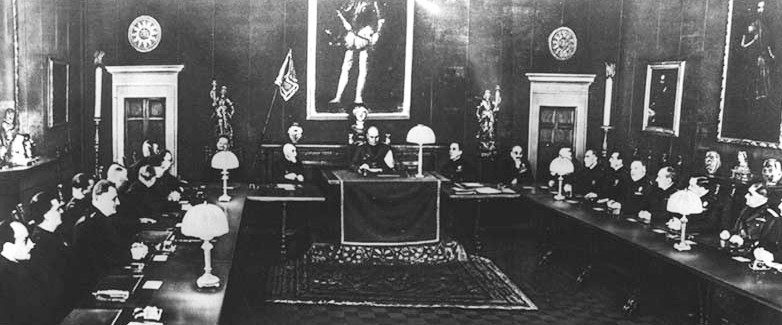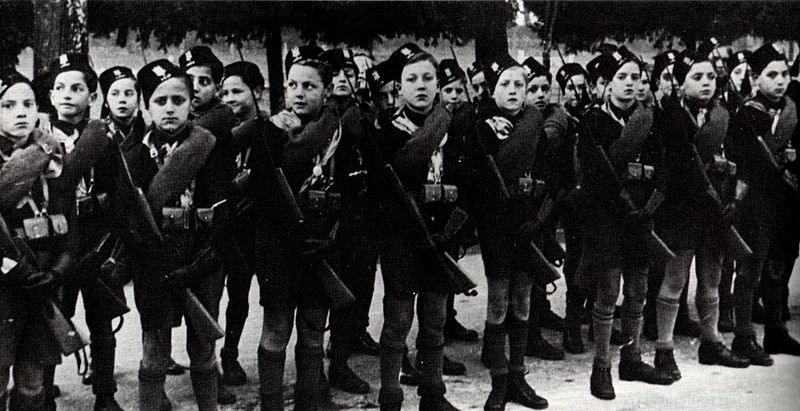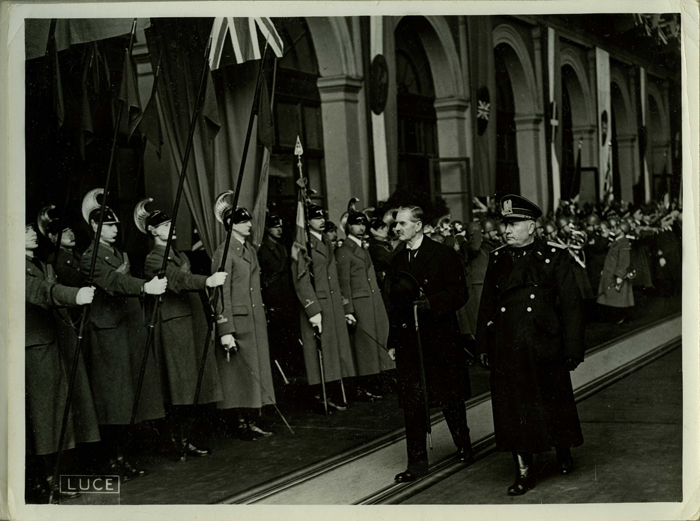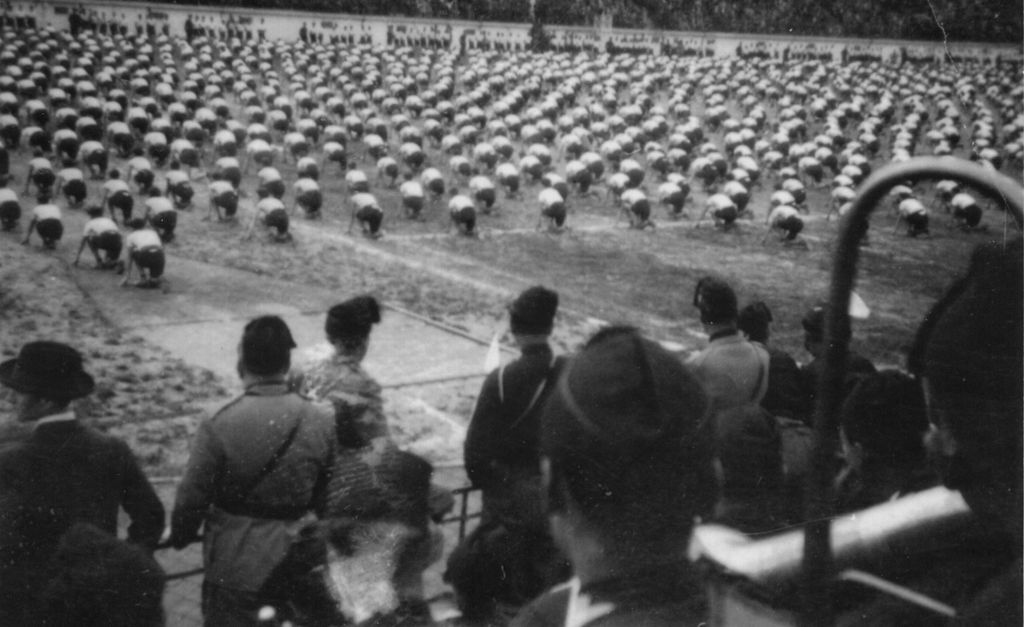Mussolini — for the first time in history — consistently put into action in Italy the whole system of main concepts of radical-right wing elite theory: Pareto and Mosca, Michels and Le Bon, Sorel and Gentile.
Editor’s note: Fascists, as the example of the World Anti Communist League taught us, are like chameleons. They change form depending on circumstances. When they need to come to power, they want you to like them. Once they are there, they don’t need your opinion anymore, to an extent of physically destroying all opposition. This way, when fascists brought Mussolini to power in Italy, he cancelled all democracy in the party – and in the country. Because fascism, according to Mussolini, must not have become ill of “electoral fever”. The World Anti Communist League which consisted of most notorious fascist criminals in the world now calls itself “World League for Freedom and Democracy”, but fascism remains in their essence. What always remains constant is the essence of fascism. Remember the lessons Italy learned the hard way when you listen to the far-right parties during the “democratic” debates.
If we could learn to look instead of gawking,
We’d see the horror in the heart of farce,
If only we could act instead of talking,
We wouldn’t always end up on our arse.
This was the thing that nearly had us mastered;
Don’t rejoice in his defeat, you men!
Although the world stood up and stopped the bastard,
The bitch that bore him is in heat again.Bertolt Brecht
Since the mid-1920s the rule of Mussolini and his party in Italy became almost indisputable. The remaining undefeated communists went underground. The socialists were politically crushed, a significant part of socialists joined the fascist party. Democrats, as well as the majority of Popolare Catholics became Mussolini’s allies after the peace between Vatican and fascists was made.
The Parliament and the king, taking into account the numbers of armed black-shirt squadre, obediently supported every Mussolini’s initiative. The industrial, rural and trade capital provided broad political and economic support to the fascists, being inspired by Mussolini’s anti-socialist reforms which it so much needed.
But Mussolini wanted more. He wanted absolute authority his rival D’Annunzio talked about in Fiume — but over all of Italy, and an Italy that would have ruled over the world. And, unlike D’Annunzio, understood that this is only possible when he, Duce, will receive absolute authority in the party, and when the party will receive the same kind of authority in the state.
Mussolini started with the party. And, first and foremost, with the ideology of the party.
This ideology manifested itself in three main principles.
First principle — militant and self-sacrificing patriotism, holiness of the ideas of the nation and the state. The oath of a fascist was as follows: “In the name of God and Italy, I swear to dedicate myself solely and selflessly to the good of Italy.” One of the primary and most persistently repeated fascist mottoes — “Fatherland is not to be denied, but won“.
Second principle — discipline. Soon after the fascist coup d’etat of 1923 Mussolini declared: “We will conduct the policy of rigor directed, before anything else, towards ourselves. By doing so we will gain the right of conducting it in regard to others… We need national discipline… Not Italy for fascism, but fascism for Italy.“
A strict system of disciplinary action is implemented in the fascist party for party members who committed certain offenses. The sanction of last resort — permanent expulsion from the party — meant that the offender was being declared a traitor. Next regular “purges”, called “weeding out”, took place in the party, with tens of thousands of offenders being “weeded out”.
The fascist statute of 1926 reinforced the “military” disciplinary style of the party. It read: “Fascism is the militia which serves to the nation. Its goal is the realization of the greatness of the Italian people. From its very emergence… fascism always considered itself as being at war.“
The third ideological principle of the fascist party — hierarchy and unquestionable obedience to the higher ranking party members, up to Duce, the leader.
In winter of 1926, after the government declared that all opposition newspapers were banned, an article in fascist “Impero” proclaimed: “Starting from this evening we must put an end to the stupid idea that everyone can think for themselves. Italy does have one and only head and fascism has the one and only brain, the head and the brain of the leader. Every traitors’ head must be cut off without mercy.“
The initiation oath which everyone who joined the fascist party swore was as follows: “I swear to unquestionably execute all orders of the leader and serve the cause of the fascist revolution by all my efforts and, if necessary, my blood.“
The particularities of the party organization followed from this ideology. Party congresses were cancelled, alongside with any kind of democracy and self-governance within the party. The Grand Council of Fascism, with Mussolini as its Head, was governing the party. The members of the Grand Council were party officials who occupied certain offices, as well as those appointed to the Council (Mussolini was the one who decided whom to appoint, there were no “unnecessary” people in the Council). The Grand Council was in charge of all key questions in the country, including constitutional and other legislation, as well as nominated and presented candidates to all primary state offices to the king for approval.

The statute of the party was approved by the king’s decree on paper only; it was actually written by the Grand Council and its Head, Duce. The official Head (Secretary) of the fascist party was also appointed by the king on paper only. The candidate for this post was presented to the king by Mussolini. The Grand Council of Fascism appointed the secretaries of provincial party organizations. Duce appointed the members of consultative “directories” assigned to the provincial secretary by his decrees. Provincial secretaries appointed the heads of lower party organizations who, in turn, appointed the heads of fascist unions — fascias.
Ensuring the absolute hierarchical authority in the party, Mussolini gave special attention to youth. Duce emphasized that he considers “political and spiritual rejuvenation of Italy” to be one of the primary tasks of fascism. His ally, the futurist Marinetti, even proposed to “kick out of politics” the upper house of the Parliament, the aristocratic Senate as the “Council of Elders”, and replace it with the “Council of Youth”. Youth was being actively getting involved with the party.
At the same time fascist attentively studied and adopted the Soviet experience. Senior high-school students and university students were organized in a kind of Soviet Komsomol (“L’Avanguardista”), junior students — in a kind of Soviet pioneers (“Balilla”). But — unlike USSR — there were no elections, no democracy in party fascias, Avanguardista and Balilla, no attempts to think for yourself were allowed.
By fall of 1926 the fascist “core” of Mussolini’s rule was comprised of over 10 thousand “adult” fascias with over 1 million members, plus approximately 4 thousand “Avanguardista” fascias (over 200 thousand members) and approximately 5 thousand fascias of “Balilla” (over 270 thousand members).

At the same time Mussolini, having formally received the Parliamentary and governmental power, wasn’t intending to rule by means of representative institutes at all. In March 1924 he declared: “I don’t want fascism to become ill with electoral fever. I want the fascist party to enter the Parliament, but I want fascism itself to stay outside — to control and inspire the representatives. The National Fascist Party must forever remain an untouchable reserve of the fascist revolution.“
Fascist militia became Mussolini’s primary instrument of authority — an “armed squad” of fascist dictatorship which put under its control not only all of the functions of domestic and foreign security, but also the main part of the state, political, economic, social governance system. The core of fascist militia was the “national guard”, mostly comprised of former military squadre and arditi; its “periphery” was the rest of the party, which comprised the “reserve” of the national guard. Civil servants and many specialized “polices” were recruited from the numbers from the latter.
Fascist militia guards the domestic order and the state borders, conducts political investigations, keeps track of syndicates, supervises pre-army military training of “Avanguardista”, etc.
At the same time Mussolini creates the fascist regime of state authority. At the end of 1925 the king approved the “Provision on the First Minister”, according to which the Prime Minister is only answerable to the king, while the ministers are answerable to the king and the Prime Minister. In spring 1926 the Prime Minister received the right to issue decrees legally equivalent to laws. Meaning, the real legislative authority of the Parliament was in practice terminated.
Local government was reorganized during the summer of the same year. The local elected self-governing bodies were dissolved. A position of a state official — podesta — appointed by the king’s decree (meaning, someone proposed by the Grand Council of Fascism) was implemented instead, along with a local authority council consisting of members of local fascist syndicates.
In fall of 1926, after yet another attempt on Mussolini’s life, the king issues a decree “On Defending the State”. It restored the capital punishment cancelled dozens of years before, introduced special “political” military courts and concluded the defeat of all parties and organizations which were even to a slightest degree opposed to fascism.
Military courts sentenced the “politically unreliable” to a long time in prison or to banishment to distant islands (this is how, in particular, Antonio Gramsci was first sentenced in 1926 to banishment to Ustica island, then to 20 years in prison). Strikes were banned and punishable by a large fine or prison. Conflict between syndicates of entrepreneurs and workers were resolved by state “labor courts”, not abiding to their decisions was a criminal offense.
In response to the accusations of persecution of opposition Mussolini states: “Opposition is not necessary in a healthy political regime, and it is redundant in a perfect regime, which a fascist regime is. There is only a place for fascists and a-fascists in Italy, because the latter are exemplary citizens.”
Now Mussolini really did possess absolute power. And he used it to the fullest — in the spirit of a well-learned radical-right wing elite theory.
In full accordance with the concepts of Mosca and Le Bon, Duce enhanced his cult of the Leader both in the party and in the country. He copied and enriched the “Fiume” theatrical and hypnotic style and entourage of D’Annunzio in his regular public speeches. The fascist propaganda became persistent and omnipresent — in schools and universities, in fascias of “Avanguardista” and “Balilla”, in the press, in movies, radio, theatrical productions and sport events.
Mussolini’s propaganda was building and transmitting the bright fascist myth exactly according to Sorel’s concept, while fascist militia was supporting this myth with the methods of “direct violent action”.
Three main themes were at the core of this myth.
The first theme was the historical project of recreating the “ancient Roman” grandeur of Italy, declared by Corradini and D’Annunzio and expanded by Mussolini by including in it all historical achievements of the country.
The second theme (here Mussolini used Gentile’s concept to the fullest) — fascism as a totalitarian entity of a totalitarian state which is capable of realizing (and successfully realizes!) a historical project. Mussolini and Gentile put these ideas into simple formulas. For example, “Everything in the state, nothing against the state and nothing outside the state“; “Fascism is the genius of a reborn race, a Latin tradition eternally functioning in the thousands of years of our history… the synthesis of the glorious past with the radiant future“.
The third theme — the great leader Mussolini as a personification and the “brain” behind the historical project, fascism and totalitarian state realizing the project.
Of course, the fascist myth required to be supported by reality. Mussolini learned the conclusions of Pareto and Sorel that the created crowd cannot be held “in willing obedience” without such a support.
The fascist militia dramatically decreased the crime rates in the country. Giant stadiums were being built and filed with participants of tournaments, people visited the renovated museums, new theatres and concert halls. Mussolini declared that the “Fate of the nation depends on its demographic might“. Fertility was encouraged: a state tax on bachelors was implemented, many new hospitals and women’s health clinics were built.
Mussolini reorganized the corporatist-syndicalist system of the country, tightening the fascist control over it and filling this control with specialists-managers. He initiated the land reclamation programs which created almost 8 mln. hectares of new lands for agriculture in the country. The system of new hydroelectric power stations decreased the country’s dependency from imported coal, new cities appeared, a powerful new trade and military fleet was created, aviation industry was being developed, the system of ports was renewed, the towns were getting plumbed, railroads were built. The country was getting richer, bigger — and more armed.
Duce himself was acting as an “exemplary fascist”: he practiced fencing, swimming, horseback riding, sailing, motorsport, sport aviation. He participated in all of significant events in the country, appearing before the people and masterfully transmitting the fascist myth to them.
By doing so Mussolini — for the first time in history — consistently put into action in Italy the whole system of main concepts of radical-right wing elite theory: of Pareto and Mosca, Michels and Le Bon, Sorel and Gentile. As a result he was able to deeply supersede the “uplifting” collectivism of the rational masses which realize their interests and goals, quite strong in “syndicalist Italy”, in the majority of the population in favor of regressive national-collectivism of a thoughtless irrational crowd, enthusiastically obeying the leader, for a long time.
The dusk of the “fascist myth” started in 1932-34 due to the pressure caused by the “Great Depression”: the country was plagued by mass unemployment. Decrees on the reduction of the work day and dramatic decrease of wages were issued in order to preserve the employment level.
The details of the transformation and the history of the defeat of Italian fascism are described in many works and are not related to our topic. Let us just note that “willing obedience of the crowd” was under question already during the war of Italy in Abyssinia (Ethiopia) in 1935, the response of the League of Nations to which was international sanctions, as well as in 1936, when Mussolini, together with Hitler, intervened in the Spanish Civil War on Franco’s side. When Duce made an alliance with Hitler in World War II, “self-sacrificing heroism of fascist cohorts” didn’t last for long. In 1943, after a string of serious defeats of Italy in Africa and the Soviet Union, Mussolini got betrayed by almost all of his fascist allies. Fascism in Italy came to its end.
Nevertheless, Mussolini’s “fascist experiment” greatly influenced the whole world. Exactly as a conceptual, ideological, political, economical, social alternative to liberalism, communism and, especially, the Soviet experiment that actually lived. Winston Churchill and Sigmund Freud admired Mussolini. Degrelle in Belgium, Dollfuss in Austria, Codreanu in Romania and other leaders of European fascist regimes took after Mussolini.
The most attentive student and user of Mussolini’s conceptual, ideological, economical, political, social experience was Hitler. This is what we will talk about next.
Source (for copy): https://eu.eot.su/?p=3279
This is the translation of the eighth article (first published in “Essence of Time” newspaper issue 61 on January 22nd, 2014) by Yury Byaly of a series on essence, birth and rise of fascism. Part 1: Marxism, imperialism and the justification of inequality. Part 2. Part 3. Part 4. Part 5. Part 6. Part 7.





